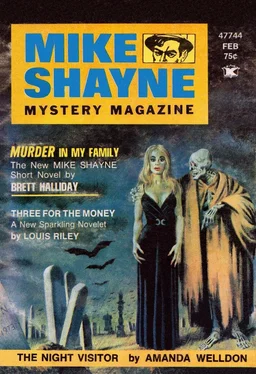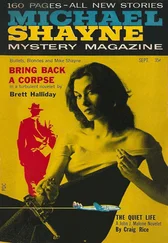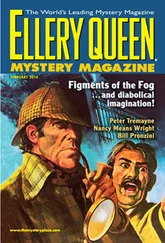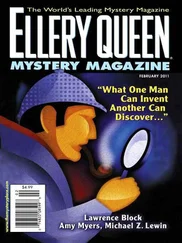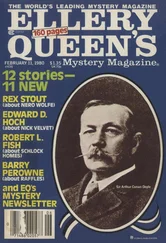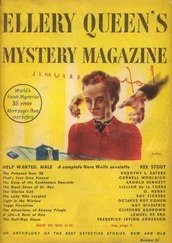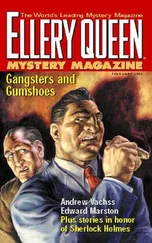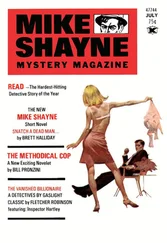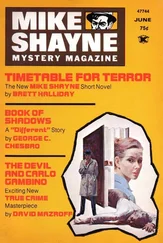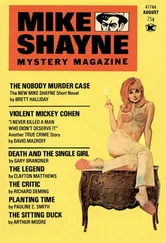Бретт Холлидей - Mike Shayne Mystery Magazine, Vol. 34, No. 3, February 1974
Здесь есть возможность читать онлайн «Бретт Холлидей - Mike Shayne Mystery Magazine, Vol. 34, No. 3, February 1974» весь текст электронной книги совершенно бесплатно (целиком полную версию без сокращений). В некоторых случаях можно слушать аудио, скачать через торрент в формате fb2 и присутствует краткое содержание. Город: Los Angeles, Год выпуска: 1974, Издательство: Renown Publications, Жанр: Детектив, на английском языке. Описание произведения, (предисловие) а так же отзывы посетителей доступны на портале библиотеки ЛибКат.
- Название:Mike Shayne Mystery Magazine, Vol. 34, No. 3, February 1974
- Автор:
- Издательство:Renown Publications
- Жанр:
- Год:1974
- Город:Los Angeles
- ISBN:нет данных
- Рейтинг книги:3 / 5. Голосов: 1
-
Избранное:Добавить в избранное
- Отзывы:
-
Ваша оценка:
- 60
- 1
- 2
- 3
- 4
- 5
Mike Shayne Mystery Magazine, Vol. 34, No. 3, February 1974: краткое содержание, описание и аннотация
Предлагаем к чтению аннотацию, описание, краткое содержание или предисловие (зависит от того, что написал сам автор книги «Mike Shayne Mystery Magazine, Vol. 34, No. 3, February 1974»). Если вы не нашли необходимую информацию о книге — напишите в комментариях, мы постараемся отыскать её.
Mike Shayne Mystery Magazine, Vol. 34, No. 3, February 1974 — читать онлайн бесплатно полную книгу (весь текст) целиком
Ниже представлен текст книги, разбитый по страницам. Система сохранения места последней прочитанной страницы, позволяет с удобством читать онлайн бесплатно книгу «Mike Shayne Mystery Magazine, Vol. 34, No. 3, February 1974», без необходимости каждый раз заново искать на чём Вы остановились. Поставьте закладку, и сможете в любой момент перейти на страницу, на которой закончили чтение.
Интервал:
Закладка:
At twelve-thirty, Sheriff Strowe tumbled into bed. The lost record ached a little inside him, until his wife woke and kissing him on the cheek said, “Records were made to be broken, Quinn.”
And then he was all right with it, felt all right about having it for twenty years, and he dropped off to sleep. He could sleep until eight a.m. now, he was sure.
It wasn’t eight a.m. when he woke, however. And it wasn’t to the bedroom alarm clock. He woke to an incessantly ringing extension telephone on the nightstand. It was Patrolman Storey.
“What is it, Storey?” he asked.
“It’s bad, Quinn, out at Lake Loon. I went down there for a routine check of the picnic grounds. Down Cottage Grove Road from the highway. I found fresh tire tracks leading down to the lake’s edge, but no overlap of a car backing away. Lot of footprints. Ground’s frozen now. They’re perfect frozen casts.”
“Where’s the car?” Strowe asked.
“My opinion? The bottom of Lake Loon,” said Storey, mincing no words.
Lake Loon was the deepest in the state, a crater bed. It had never been sounded to its depth, but fishermen had tried with weighted lines which came up free of sand. Oregon’s Crater Lake at over 1,900 feet deep was the nation’s deepest. Lake Loon was easily a close second.
By the time Strowe arrived on the scene three other patrol cars had spotlights cast on the lake edge where Patrolman Storey believed a car had gone over and down.
Over and down was the only way a car entered Lake Loon at this spot. No public bathing, only picnics, softball and tennis. About three hundred feet down, the lake was collared with a fifty-foot sloping ledge. From there the black waters ran off into oblivion.
Patrolman Storey had read the auto tracks correctly. A car had drawn itself to the lake’s edge. But the perfect, unobliterated tread told them it didn’t back or swing out. And that left straight down.
“Foreign job, or economy compact,” said Storey to Ev Strowe. “Footprints only on the passenger side here,” he pointed out to Strowe with a flashlight. “Might indicate the driver went down in the car.” Storey involuntarily shivered.
“Or that the driver didn’t go down in the car, was alone, and pushed it over the edge like off a cliff to rid himself of an economy clunker.”
Storey escorted the sheriff around to where the back of a car would have come to rest and re-trained his flashlight. “More footprints. One set. Where he pushed it in from the rear. Then they trail off, back up Cottage Grove Road about two hundred yards until the road becomes grassy. At that point they disappear.”
The prints were large. Male footprints, very likely. And something else about them were instantly familiar to Sheriff Strowe. “You played a little basketball for Zachary High, didn’t you, Storey?” the sheriff asked.
“Second-string, ’61. I got into the game around garbage time.”
“Those prints mean anything to you?”
Storey knelt and examined them more closely. He rose nodding. “Athletic shoes; basketball shoes.”
“Step into one of them, Storey,” Strowe said. “You can’t damage it. The ground’s frozen like a board.”
Patrolman Storey did so, with a little room to spare all around. “I’m a ten. Size-ten basketball sneakers.”
“Add a whisper for your street shoes and what would you guess?”
“Size-10½,” said Storey. “Couldn’t be size-11’s and basketball sneakers only come in even and half sizes. Yes, 10½’s.”
“In the morning we’ll get one of those cherrypickers from Zeldenrust’s Machinery Rentals. You’ve had driver training, haven’t you, Storey? You and Phil Groat and Carl Ritzer?”
Storey nodded. “I’ll arrange for the cherry picker,” said Sheriff Strowe. “Get on the radio and tell Groat and Ritzer to go home and grab a couple hours sleep and be down here with wetsuits and oxygen tanks at nine in the morning.”
Storey turned and cast his glance at the dark lake, where a thin sheet of ice showed a glaze for twenty-feet out. “Think it’s hung up on the ledge?”
“If it didn’t roll, or land on its nose and topple.”
“Hope it’s empty,” Storey said. It went without saying.
It was a 1964 economy compact and the ledge had held its offering. The body of the dead girl inside, on the floor below the front seat, was the body of Julie Knight. Two large bruises on her right cheek and a third on her forehead made the pretty, almost perfect face now imperfect and puffy.
The car was Julie Knight’s, bought for her by her parents less than five months earlier. Not a new car, not an old one. Just something a teenage girl adores and perhaps names Snoopy and knocks around town in with her friends. It was funny — or perhaps not so now that he thought about it — but the only face Sheriff Strowe could see seated next to Julie Knight on the passenger side was the handsome, athletically rugged face of Lonnie Davenport.
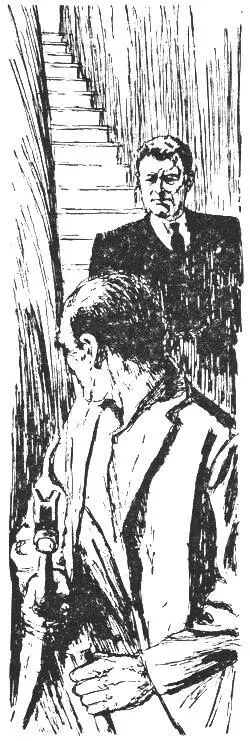
The county autopsy surgeon placed the time of death at 1:20 a.m., a full hour before the ground had frozen the killer’s footprints from mud to hardened casts.
Death not from drowning, but from blows delivered with a blunt object on Julie Knight’s face and forehead.
Sheriff Strowe allowed the funeral to take place and a week’s gossip to pass and then he began asking questions.
He asked his most important questions of Lonnie Davenport, who had been seen by scores of classmates and townspeople after the Forks basketball game, in the company of Julie Knight.
“I met her in the student parking lot next to the gym after the game, Sheriff Strowe,” Davenport told the sheriff at his home on a subsequent weekday after school. “I mean, she always met me after the games. Football, basketball, baseball.”
“Whose car did you leave in?” Strowe wanted to know.
“Her little economy job. The Atomic Clock, she called it. Atomic clocks use vibrations to run. It was the most vibrating clunker on the face of the earth. I left my car parked in the lot, like I always do when we hit the main drag to celebrate a victory.”
“Where did you and Julie go on the night of the Forks game?”
“Let me see—” the boy hesitated.
“We already have statements from witnesses,” said Sheriff Strowe, indicating it might be wise of Lonnie to display honest, total recall.
“Well, we stopped in at the Burgerama. Two dozen kids must have seen us there plus the waitress, Mink Elingson. She’s a Zachary High junior.”
“What time did you leave the Burgerama?”
“Around eleven o’clock. After that we dropped into the Tiger Den on South Commercial, four blocks from the school. It’s a jock hang-out. We left there about twelve, maybe a little before. Julia drove me back to the student lot near the gym. Add about a half-hour for getting-to-know-you time, Tactility Sessions, we call them. Touch. About 12:15 a.m., we said goodnight. I drove home in my car and Julie left in hers. That’s the last I saw of her.”
“You didn’t drive in her car down to the picnic grounds on Lake Loon,” Sheriff Strowe wanted made clear.
“Cold as it was that night? No way. I remember that distinctly. It was the first freeze of the new year. We had all we could do to keep from freezing that half hour we were parked in the school lot. Her heater is a real turkey.” He dropped his head then, suddenly: “Was.”
“I’m curious to know why you didn’t sit in your car for that Tactility Session?” Sheriff Strowe rushed on, to get them past the word Was. “You’ve got a ’70-model fastback, haven’t you?”
Читать дальшеИнтервал:
Закладка:
Похожие книги на «Mike Shayne Mystery Magazine, Vol. 34, No. 3, February 1974»
Представляем Вашему вниманию похожие книги на «Mike Shayne Mystery Magazine, Vol. 34, No. 3, February 1974» списком для выбора. Мы отобрали схожую по названию и смыслу литературу в надежде предоставить читателям больше вариантов отыскать новые, интересные, ещё непрочитанные произведения.
Обсуждение, отзывы о книге «Mike Shayne Mystery Magazine, Vol. 34, No. 3, February 1974» и просто собственные мнения читателей. Оставьте ваши комментарии, напишите, что Вы думаете о произведении, его смысле или главных героях. Укажите что конкретно понравилось, а что нет, и почему Вы так считаете.
